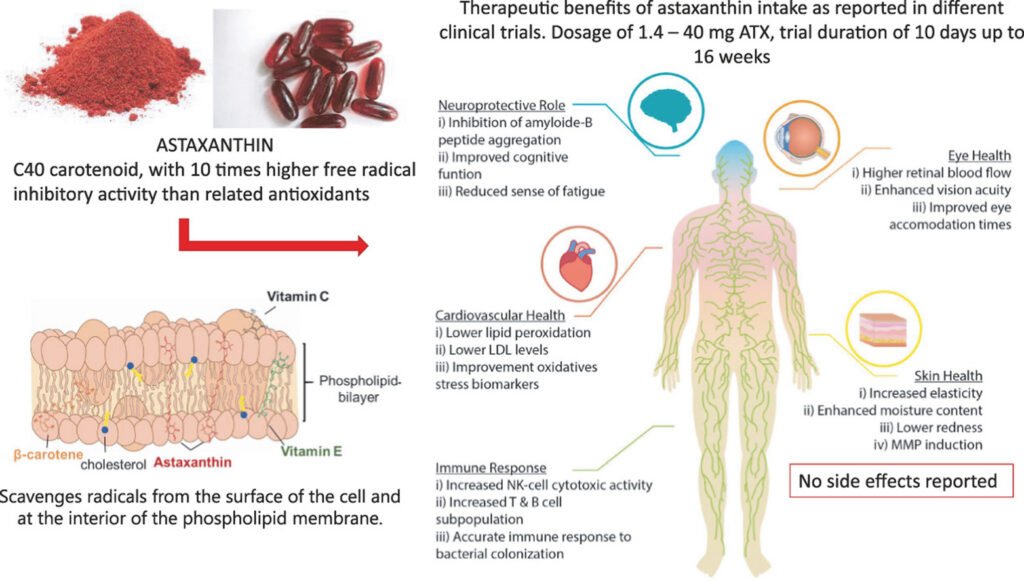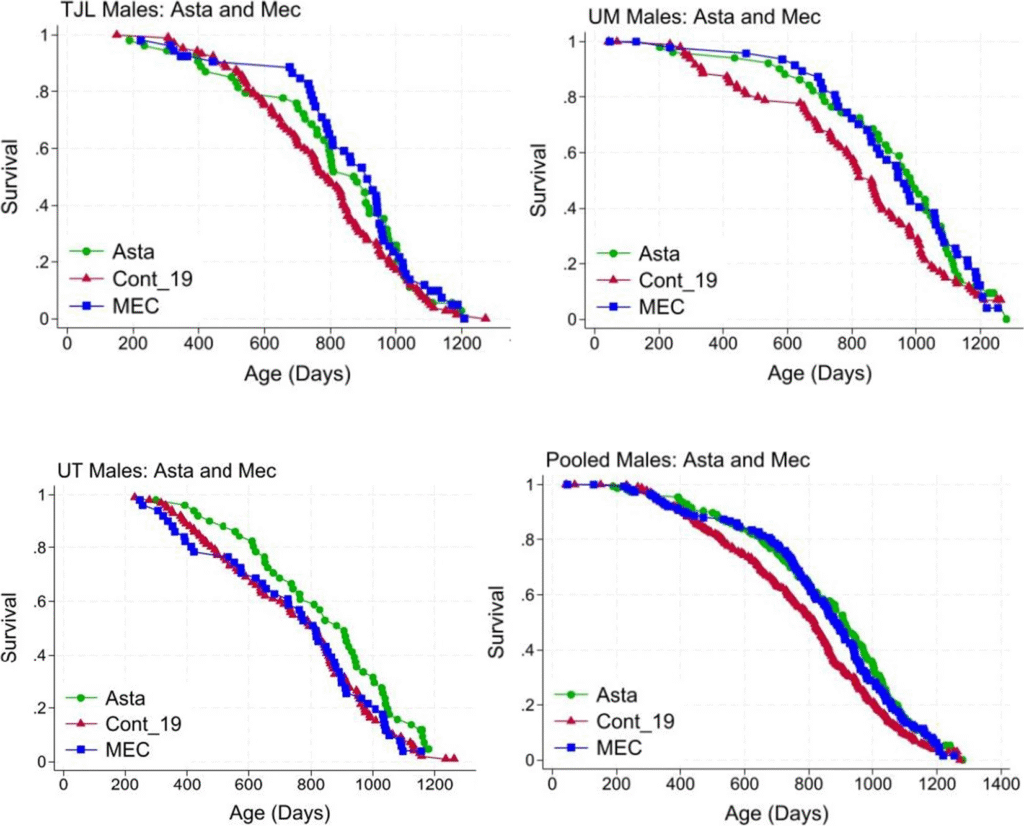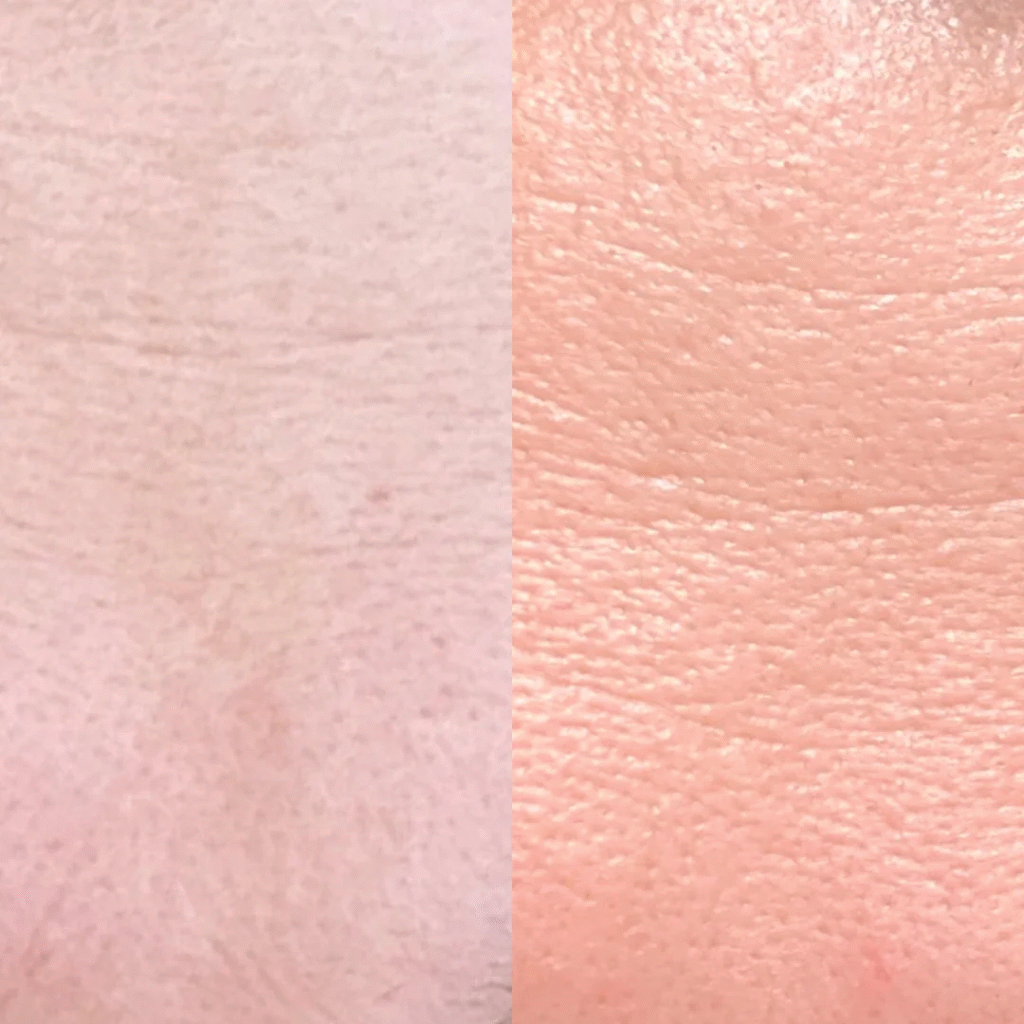Astaxanthin is a potent antioxidant carotenoid, famously responsible for the pink coloration of flamingos, shrimp, and crabs. Consequently, this is what farmed salmon today receive to get their characteristic pink / orange colour, as they do not have enough of it in their diet. Its unique molecular structure gives it strong free radical scavenging capacity and allows it to embed within cell membranes, providing both direct and indirect antioxidant effects.

Longevity and Healthspan in Animal Models
A robust body of preclinical evidence demonstrates that astaxanthin supplementation improves healthspan and can extend lifespan in mice under controlled conditions:
Harrison et al., 2024 (Interventions Testing Program, ITP):
Dietary supplementation with astaxanthin (UM-HET3 mice, ~1840 ppm; approx. 20–40 mg/kg/day) led to a significant extension of median and maximum lifespan in male mice only, with no effect in females. Improved markers of metabolic health and lower cancer incidence were observed. The lack of effect in females is not explained by differences in body weight, and the authors note that the doses used may not have been optimal for females. Female controls also had longer lifespans overall. Another possible link might be estrogen, as female mice don’t enter a menopause like in humans.

Ikeuchi et al., 2006:
Astaxanthin administered at 1.2, 6, or 30 mg/kg/day for 5 weeks improved exercise endurance and fat utilization in mice, suggesting beneficial effects on mitochondrial efficiency and metabolic flexibility.
Reference: Biol Pharm Bull. 2006 Nov;29(11):2106-10. doi:10.1248/bpb.29.2106

This is a frequently cited paper on astaxanthin and endurance, but the findings need perspective. The study showed dramatic improvements in mouse swimming time ( 2 to 5 minutes), but this level of effect is unusually large for any supplement and has not been replicated in other robust animal or human studies. The experiment was short-term and focused on a single, highly variable endurance test with young male mice only. While the results are popular in the supplement world, they don’t translate to meaningful anti-aging or longevity outcomes and should be interpreted with caution. Another reason for this is that such a benefit, even coming close to that has not been replicated in human studies with astaxanthin.
Brown et al., 2018 (Front Nutr): 3–5 weeks of supplementation improved fat metabolism and endurance performance in mice; however, human translation showed no effect at similar exposure. DOI: 10.3389/fnut.2017.00076
100 mg/kg/day in hairless mice: Prevented UV-induced dermal aging and capillary regression in skin, promoting anti-aging effects. DOI: 10.3390/biomedicines8020018
Mechanistically, these effects are attributed to a reduction in oxidative damage, improved mitochondrial function, modulation of inflammation, and maintenance of metabolic homeostasis.
Human Clinical Trials—What Has Actually Been Shown?
- Skin/Photoaging: Improved skin moisture, elasticity, and reduced wrinkles at 4–6 mg/day, 6–16 weeks.
- Tominaga K et al
- Ito N et al., 2018
- Antioxidant/Inflammatory: Reduced markers of oxidative stress (MDA, 8-OHdG), increased SOD, and lowered CRP at 6–12 mg/day.
- Choi HD et al., 2011
- Metabolic/Diabetes: Lowered fasting blood glucose, reduced triglycerides, and improved HDL in type 2 diabetics at 8 mg/day.
- Mashhadi NS et al., 2018
- Vision/Fatigue: Decreased eye fatigue and improved retinal blood flow at 6 mg/day, 4–8 weeks.
- Nagaki Y et al., 2002
- Immunity/Inflammation: Lowered DNA damage and CRP, increased NK cell activity at 2–8 mg/day.
- Park JS et al., 2010
No serious adverse effects have been observed even at doses up to 40–50 mg/day short-term.
| Study | Population | Astaxanthin Form* | Dose | Duration | Main Findings |
|---|---|---|---|---|---|
| Tominaga, 2012 | 65 women | 4 mg capsule | 4 mg/day | 8 weeks | ↑ skin elasticity, ↓ wrinkles, ↑ UV resistance |
| Ito, 2018 | 44 adults | 4 mg/day gel-caps | 4 mg/day | 16 weeks | ↓ wrinkle depth, ↑ skin hydration |
| Choi, 2011 | 30 overweight | 5 & 20 mg oil capsule | 5/20 mg/day | 3 weeks | ↓ MDA, ↑ antioxidant enzymes |
| Park, 2010 | 42 women | 2 & 8 mg capsule | 2/8 mg/day | 8 weeks | ↓ CRP, DNA damage; ↑ NK-cell activity |
| Mashhadi, 2018 | 44 diabetics | 8 mg/day | 8 mg/day | 8 weeks | ↓ glucose, ↓ triglycerides, ↑ HDL |
| Nagaki, 2002 | 20 adults | 5 mg/day | 5 mg/day | 4 weeks | ↓ eye fatigue |
| Saito, 2012 | 26 adults | 6 mg/day | 6 mg/day | 6 weeks | ↓ visual fatigue |
Astaxanthin Reduces NO
Mechanisms:
- Direct scavenging: Astaxanthin neutralizes peroxynitrite (ONOO–), a product of NO and superoxide, and can directly reduce excess NO
- Downregulation of iNOS: Astaxanthin suppresses iNOS gene expression via NF-κB inhibition, leading to lower NO production during inflammation
- Clinical impact: In some people, this may decrease vasodilation and contribute to side effects like cold/purple extremities or erectile/vascular issues at higher doses.
Current Clinical Trials (as of June 2025)
A scan of clinicaltrials.gov and WHO registry reveals ongoing or recent trials for astaxanthin in the following areas:
- Nonalcoholic fatty liver disease (NAFLD)
- Type 2 diabetes/metabolic syndrome
- Cognitive impairment/Alzheimer’s
- Male fertility and sperm oxidative stress
- Macular degeneration/diabetic retinopathy
- Cardiovascular risk/dyslipidemia
- Rheumatoid arthritis and other autoimmune disorders
- PCOS
- Exercise performance/recovery
- Atopic dermatitis and chronic skin inflammation
Extraction and Supplementation
Astaxanthin is most commonly produced from the green microalga Haematococcus pluvialis, which accumulates large amounts under stress. Commercial extraction methods include solvent extraction (acetone, ethanol, edible oils), supercritical CO₂ extraction (the cleanest and most potent), and encapsulation to prevent oxidation.
- Synthetic astaxanthin (often found in fish feed, not supplements) has lower biological activity and is not recommended for human use.
- Key point: The best supplements are derived from Haematococcus pluvialis, extracted via supercritical CO₂ or cold oil extraction, and are preferably stabilized or encapsulated (e.g., with olive oil, phospholipids, or micellar formulations) for maximum bioavailability and minimal oxidation.
The effects of these might be very minimal though, as there was a clinical trial in 2016, Sponsored by the Company Cyanotech, which claim to produce natural astaxanthin through their own production methods. https://www.clinicaltrials.gov/study/NCT02397811
Cyanotech sell all kinds of astaxanthin on their website despite the study, which could be interpreted as them not having found a major difference between the formulations and not publishing the results to lose their competitive advantage.
User Anecdotes (Verbatim)
- Reddit – r/Supplements
“12mg astaxanthin + beta carotene & lutein. Developed a nice, reasonable, but light skin coloration. Almost too subtle; if I take it again I’ll bump it up to 24mg.”(OatsAndWhey) - “I take 12mg/day (BioAstin) for several years, fair caucasian. I have a natural, lightly tanned color and haven’t had a sunburn ever since.”
(Simple_Song8962) - “12mg darkens skin a little, most noticeable armpits when arms hang. Goes away after stopping.”(laktes)
- “I did 24mg liposomal astaxanthin, 60mg lycopene, and 20mg lutein daily for 6 weeks. The effects were dramatic: my palms were quite pink, and sunburns ceased.”(wagonspraggs)
- “24mg + 50mg lycopene for 2 months: skin started changing colour.”(10Ambulance)
- “24mg liposomal for ~2 years, fair-skinned, no tan despite outdoor work with sunscreen & hat.”(aurora_rosealis)
- “6 months at 12mg, maybe less pale but nothing big.”(Icanheargodlaughing)
- “12mg daily, fair-skinned. 1 month: none that I can tell. 2 months: Nope.”(Reficul_gninromrats)
- “I’ve been taking 12mg or more per day for like two years… I look like I have healthier skin. Not as noticeable as carotenemia.”(aesthet)
- “12mg Micro Ingredients daily. Feet turned purple when standing, went back to normal on movement.”(Tabbbbbbjayyy)
- “Absolutely destroyed libido.”(dras333)
- “6mg for 4 months, libido destroyed too.”(Dull_Minute)
- “4mg/day caused muscle/vision disturbances resolved on stopping.”(deleted user)
- “Took 12mg but got red poops within 1.5 weeks, stopped to 6mg every two days.”(jonoave)
- “Astaxanthin, 12 mg/day for a year, no notable side effects, skin a bit less sensitive to sun.”(dinosdad)
- “Skin went back to pale within weeks of stopping astaxanthin (after months on 12 mg/day).”(user)
- “Noticed less sunburn after using astaxanthin for summer, previously burned easily.”(user)
- Looksmax.org
“12 mg for 3 weeks, absolutely nothing…no change in skin color.”(user)
“Anecdotally, 12 mg for 3 months: no effect. Only carotene made my skin yellow/orange.”(zoddy) - Longecity
“Tried 4 mg for 2 months, no color change, no effect on skin.”(harak1r1)
“12 mg/day, nothing after 5 months, maybe paler after stopping.”(OmniHealer) - Bluelight.org
“Took 12 mg for 1 year, didn’t notice any difference in skin tone or health.”(tammer)
I want to take it – How do I know it works?
Because astaxanthin is a visible pigment with biological activity, certain observable “signals” can hint at its presence or action in the body:
- Skin color change: A faint pink-orange tint in skin or hands can signal substantial astaxanthin deposition. While not universally seen, when present it indicates that high doses are reaching the skin layers. However, this coloration is not proof of efficacy – it merely shows uptake. Anecdotally, users who go pale after stopping imply the tint is reversible and dose-dependentreddit.com. Medically, mild skin-orange (carotenoderma) from carotenoids is benign. Thus, a subtle color shift could reassure that astaxanthin is in the system, but lack of visible change doesn’t mean it’s inactive (some users never see a color change even on 12+ mg).
- Improved skin protection: Enhanced tolerance to sun or reduced UV damage is a more functional sign. Astaxanthin has been shown in small human trials to reduce UV-induced erythema and improve skin hydration/elasticity. For example, 2 mg/day for 6 weeks significantly increased skin moisture and elasticity versus placebopmc.ncbi.nlm.nih.gov, and another trial found astaxanthin reduced UVB-induced redness by ~60% at 98 hours post-exposurepmc.ncbi.nlm.nih.gov. Anecdotally, a Reddit user took astaxanthin for a season and reported no sun rashes despite prior sensitivityreddit.com. Such effects suggest active photoprotection (antioxidant activity) in the skin. If a user notices less sunburn or improved skin repair while on astaxanthin, this is a positive sign of its antioxidant role. However, sunscreen and other factors can confound this signal.
- Vascular/physiological effects: Some reported side-effects like purple extremities or reduced libido may be indirect indicators of high astaxanthin activity, but they are not desirable or general. The purple toes described by two users on 12 mgreddit.comreddit.com likely reflect unusual vascular response (one hematologist said “not harming me” but it was unsettlingreddit.com). This could theoretically signal that astaxanthin is affecting blood properties (perhaps viscosity or circulation), but it is more a cautionary note on overdose. Similarly, libido loss/ED reported at 4–12 mgreddit.comreddit.com stems from astaxanthin’s mild DHT-inhibiting effectreddit.com and nitric oxide impactreddit.com. While these reveal that astaxanthin can be systemically potent, they are not “health” signals but rather side-effects. In summary, visual skin changes and improved sun tolerance can be viewed as positive external signals that astaxanthin is present and active in tissues. By contrast, vascular and hormonal side-effects (purpling, ED) are not useful efficacy markers; they likely indicate excessive dosing or individual sensitivity, and should prompt dose reduction rather than serve as a beneficial signal.

Astaxanthin Safety Profile:
In animal studies, mice and rats were given astaxanthin at doses up to 1400 mg/kg/day (mice) and 1000 mg/kg/day (rats), which is 1000–5000 times higher than typical human supplemental doses (4–12 mg/day). Only slight hepatotoxicity (elevated liver enzymes, mild hypertrophy) was observed at the highest doses. The main toxic finding in rats was a higher rate of benign hepatocellular adenoma in females at ≥200 mg/kg/day, but this is considered secondary to hepatotoxicity and regeneration and is regarded as a species-specific effect without clear relevance to humans. Other observed side effects include reduced weight gain and reddened stool. There was no adverse effect on survival or longevity in any group.
No evidence of carcinogenicity or liver toxicity was found in mice at up to 1400 mg/kg/day or in dogs at up to 2500 mg/kg/day. Slight increases in plasma liver enzymes and mild hepatic hypertrophy were only seen at rat doses ≥250 mg/kg/day, but not at 125 mg/kg/day.
For reference, in the 2-year rat study, the highest dose of 1000 mg/kg/day would be roughly equivalent to 70 g per day for a 70 kg human—around 5800 times more than standard clinical trial doses (12 mg/day). Even the lowest tested dose, 40 mg/kg/day, corresponds to 2.8 g per day in humans, still 230 times higher than human use.
In vitro studies:
No evidence of genotoxicity, clastogenicity, or mutagenicity was observed, even at the highest concentrations tested.
Human exposure and safety:
Average intake from salmon is 0.5–1.5 mg/day. Human trials used 6–40 mg/day for up to two months with no adverse effects.
Edwards JA, Bellion P, Beilstein P, Rümbeli R, Schierle J. (2016). Review of genotoxicity and rat carcinogenicity investigations with astaxanthin. Regulatory Toxicology and Pharmacology, 75:5–19. doi:10.1016/j.yrtph.2015.12.009